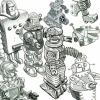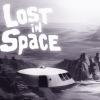|
IRWIN ALLEN FAN ART GALLERY #02 |
Updated: October 22, 2025




































































































Producer / director Irwin Allen carved out a unique niche for himself in Hollywood with a string of science fiction / adventure series on television in the 1960s, and as a maker of big-budget disaster movies in the 1970s. He became so successful in the latter endeavor that the press christened him "the master of disaster."
Born in New York City in 1916, Allen graduated from Columbia University's School of Journalism and worked as a newspaper and magazine editor before turning to writing and producing for radio. He later started his own advertising agency, but he always loved movies, and he entered the business at RKO. His earliest screen credit was as associate producer of the noir-ish thriller Where Danger Lives ( 1950 ), which had a screenplay by Charles Bennett, the veteran British screenwriter who would figure in many of Allen's later productions. In 1952 he was the writer, producer, and director of the Oscar-winning documentary The Sea Around Us. He followed this up with The Animal World ( 1956 ) for Disney.
From 1956 onward, Allen directed his attention to much bigger scale fiction films. His prior work in journalism and advertising allowed him to establish social relationships with many middle-level Hollywood stars, and those friendships became central to his success as a producer. His first independent feature, the whimsical fantasy film The Story of Mankind ( 1957 ), included a cast of
established box office names, among them Ronald Colman and Harpo, Chico, and Groucho Marx and Hedy Lamarr. His next picture, The
Big Circus ( 1959 ), included Victor Mature, Rhonda Fleming, Red Buttons, Vincent Price, Gilbert Roland, and Peter Lorre in what
was basically a lower budget variant on Cecil B. DeMille's The Greatest Show on Earth. In 1960, Allen now working with Twentieth
Century Fox produced a remake of the silent-era The Lost World, starring Claude Rains, Michael Rennie, and David Hedison. The movie got poor reviews, but its color and pacing overcame some poor special effects, and it was a box office hit. The following year, he struck gold again with Voyage to the Bottom of the Sea, featuring a cast of veteran stars, including Walter Pidgeon, Joan Fontaine, and Peter Lorre, and a screenplay by Bennett it owed a bit to Disney's Jules Verne-based 20,000 Leagues Under the Sea, as well as
to the exploits of the real-life atomic submarine Nautilus. Allen returned to Verne as a source in 1962 with Five Weeks in a Balloon, a lower budget ( but highly entertaining ) answer to Mike Todd's Around the World in 80 Days.
In 1963, Allen began looking to television as a new medium in which to work. The following year, he debuted the series Voyage to the Bottom of the Sea, based on his own film and starring Richard Basehart and David Hedison. It was an immediate success, and in 1965 he followed it up Lost in Space ( which had started life as "Space Family Robinson" ), all about a family's interstellar adventures. Although Voyage ran a season longer, Lost in Space had the biggest popular culture impact. Both shows evolved over time in a more juvenile direction, especially Lost in Space, as the characters of young Will Robinson ( Billy Mumy ), the robot, and fey, comical villain Dr. Smith ( Jonathan Harris ) came to dominate the series. Those who worked for Allen say that he was, at some level, a lot like an overgrown kid in terms of his appreciation of stories and adventure. He seemed to know what younger viewers would find exciting and he loved those explosions that seemed to go off at regular intervals on both series. He also loved old Hollywood, however, and the chance to use veteran actors, such as Francis X. Bushman and Henry Daniell, in his movies and TV shows. His production company also had several veteran actors as investors, including Groucho Marx ( whose sister-in-law Dee Hartford was one of the more memorable guest performers on Lost in Space ) and Edgar Bergen ( who gave a fine dramatic performance in an early episode of Voyage to the Bottom of the Sea ).
Allen's next series, Time Tunnel which relied on footage from the Fox film library to facilitate its heroes' travels through time only ran for one season. But with two programs in production, he was still near the top of his game as he unveiled Land of the Giants in 1968. A sci-fi / adventure show about seven travelers trapped on a world where everything is 12 times larger than on Earth, it was the most expensive series ever done for television owing to the special effects, outsized sets, and other unique requirements; it was successful enough to last for two seasons and proved enormously popular all over the world.
Allen's next few series never got past the pilot stage, but in 1972 he made a triumphant return to feature films with The Poseidon Adventure. Boasting a name cast and first-rate special effects, plus top-notch direction by Ronald Neame, this picture became
almost a license to print money and launched the whole disaster movie genre, which kept audiences filling theaters for most of the 1970s. Allen returned to the director's chair to co-direct his biggest production of all, The Towering Inferno ( 1974 ), with a
huge cast of top stars, past and present. The latter movie represented the genre's commercial peak after that, casts and disaster canvases could get bigger, but the returns still diminished. Allen closed out the genre with The Swarm, a movie that, at times, seemed to be unintentionally parodying itself, though it did give late-career paydays to Fred MacMurray, Olivia de Havilland, and
a brace of other Hollywood veterans. Following Beyond the Poseidon Adventure ( 1979 ), he continued producing for television, but retired in the late '80s and passed away in 1991. In the decades since, almost all of his major work for movies and, especially, television, has been given special deluxe treatment on DVD and cable, and Lost in Space even became a successful feature film in 1998.
|
 HOME
HOME
 About
About
 EMail Me
EMail Me TOP |
TOP |  PREVIOUS ITEM | NEXT ITEM
PREVIOUS ITEM | NEXT ITEM  ( 8 of 41 )
( 8 of 41 )




































































































